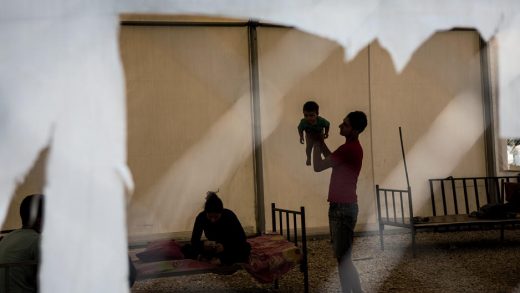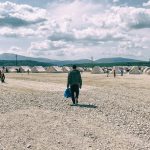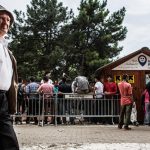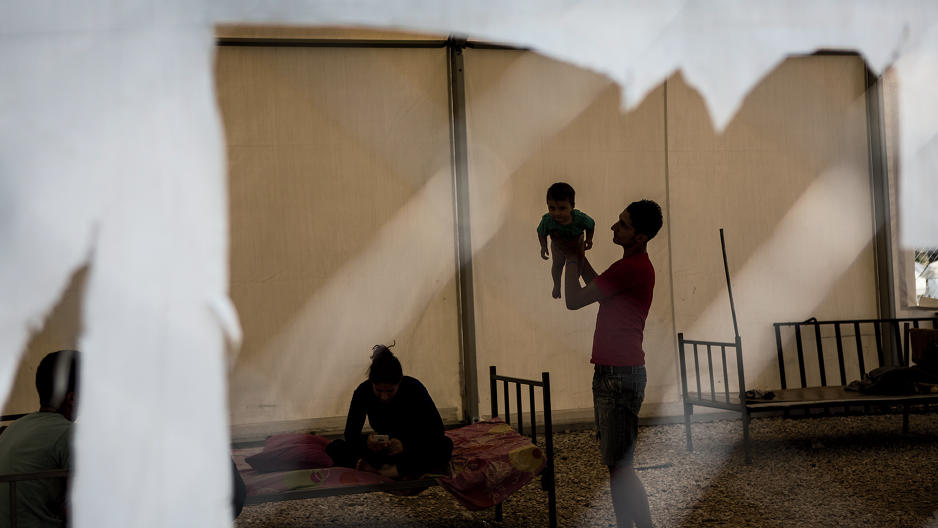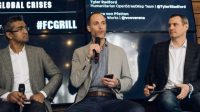How A Visionary Aid Organization Is Using Technology To Help Refugees
Former British Foreign Secretary David Miliband flew from his home in New York to the Greek city of Mytilene, on the rocky east coast of Lesbos, an island in the Aegean Sea. It was the fall of 2015, and Lesbos had for months been the primary landing point for refugees fleeing wars in Syria and Iraq.
Now the steady flow was becoming a deluge—as many as 3,000 refugees a day. Local officials were overwhelmed.
Driving north from the Lesbos airport, Miliband, the president and chief executive of the International Rescue Committee (IRC), one of the world’s largest humanitarian aid organizations, passed long lines of dazed men and women, many sunburnt and barefoot. These were the newest arrivals, an IRC staffer explained. After making it to shore, they would walk, often for days, to transit sites or government camps where they could apply for political asylum in the European Union.
Miliband stopped to examine a towering heap of life jackets that had been discarded on a beach at the north of the island. In a video he took of himself, which he later uploaded to Twitter, he read aloud from the label on one of the jackets: Will not protect against drowning. ‘Not for boating.’ Miliband, whose Jewish ancestors fled Nazi-occupied Poland in the 1940s, was reminded of the shoes found in concentration camps at the end of the Second World War—objects that came to serve as stand-ins for a different man-made tragedy. The sight “hit me hard, right in the solar plexus,” Miliband recalls today. “Just the scale of it. The agony, the fear, the pain. And so the next step was: How are we going to help these people as quickly and effectively as possible?”
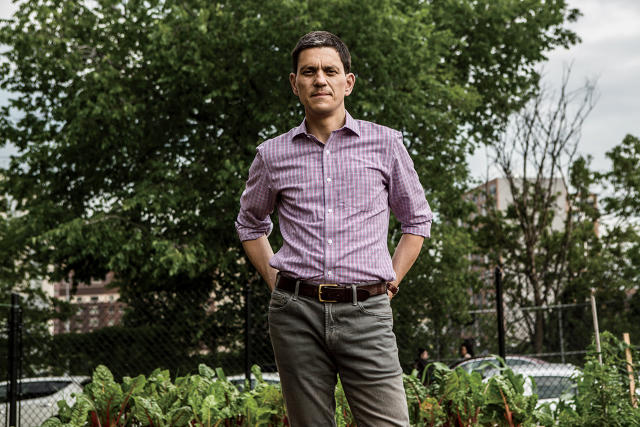
Over the next week, the IRC, which had been working in the region only for a few weeks at this point, implemented a slew of on-the-ground improvements, such as building additional sanitation and shower facilities at the two government-run camps on the island and helping move tons of gravel to a crowded transit site called Kara Tepe, which stood on the side of a rapidly eroding, muddy slope. Staffers rented a fleet of battered minibuses to carry refugees from the beaches, where they arrived, to the camps, where they’d wait—and then from the camps to the ferry terminals, where they’d depart for the mainland.
At the same time, working out of a makeshift war room at his hotel on Lesbos, Miliband and his team gave interviews to media outlets in Europe and the United States, where the IRC is based, in an attempt to apply pressure on governments. He appeared on PBS’s NewsHour, live from the port in Mytilene, to chastise the European Union for failing to adequately address the refugee influx; he told a reporter for The Guardian that “Greece and Italy have been screaming about this problem for over a year. Europe’s eye has been on different things. There has been appalling neglect.” Privately, he lobbied old government contacts directly, urging them to take action at an upcoming emergency meeting of EU regulators in Brussels.
Slowly, the tide began to turn. The Greek government agreed to increase the number of ferries leaving for the mainland, easing the logjam on Lesbos. A few months later, the European Union earmarked $325 million for humanitarian relief in Greece and other regions affected by the crisis. (The EU has pledged a total of $770 million through 2018.)
Miliband’s was hardly the only voice pressing for change, but his stature and the IRC’s reach make him perhaps the world’s most formidable advocate for disenfranchised refugees. He says that he is “encouraged” by the progress on Lesbos, but stresses that much remains to be done. Too many refugees are still on the island, trapped in limbo while awaiting asylum. “In the 21st century, to have thousands of people living in warehouses and tents—that’s unacceptable,” he says. He recites the statistics from memory: 65 million around the world forcibly displaced from their homes, a number that’s growing, according to the United Nations, by 33,000 every day. There are 21 million refugees from war-torn Afghanistan, Iraq, and Syria.

To Miliband, the refugee crisis is the defining issue of our era—a metastasizing geopolitical disaster that spills across datelines and borders and threatens the very foundations of international order. Mitigating it, he argues, will take more than a few small successes. It will require an entirely new approach, one in which social media outreach and data mining matter as much as bags of flour and mosquito netting. At the IRC, Miliband explains, this means melding “the mentality of a startup and the maturity of an 80-year-old organization.”
Since taking over as CEO in 2013, Miliband has been pushing his team to adopt new, targeted solutions for speeding up emergency response times, increasing the rigor of field studies, and implementing a culture where ideas generated by the most junior staff member in the field have as much impact as those of the CEO. “You have to think and move nimbly,” he says, “but the changes you make can’t be superficial. They have to be considered, and lasting, and backed up with real, long-term strategic vision. Otherwise, quite simply, we’ll fail.”
In Silicon Valley, failure is worn as a CEO’s badge of honor—proof that he or she has simply dreamed too big. In the arena of humanitarian aid, that notion is a luxury. Failure for an organization like the IRC means starvation, sickness, lives lost. But if the IRC can succeed in finding innovative solutions during this time of unprecedented crisis, it will demonstrate how important it is to take risks, even when—or especially when—so much hangs in the balance.
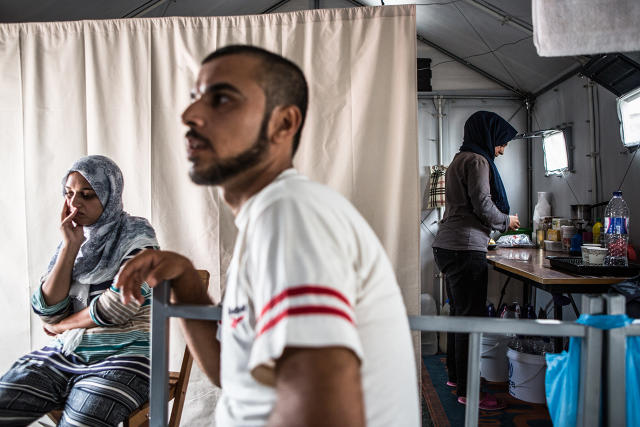
“You may not know a lot about us,” reads a recent IRC brochure. “But neither did many of the 23 million people we helped last year.”
The IRC, created in 1942 by the merger of two smaller refugee-assistance organizations—one cofounded by Albert Einstein—might be the most under-recognized yet influential nongovernmental aid group in the world. The 11,000-person organization, with offices in more than 40 countries on four continents, runs hundreds of relief programs in areas ranging from education to legal assistance, water distribution to civilian protection. It has its own emergency response unit, which functions as a kind of humanitarian expeditionary force, arriving at disaster zones early, addressing immediate needs, and staying until the situation has stabilized. It has a health technical team comprised of 50 public-health experts.
The IRC is present across what Miliband often calls “the full arc of crisis,” caring for people trapped in conflict and resettling those who manage to escape. In 2015 alone, according to the IRC’s internal count, the organization trained nearly 15,000 farmers, vaccinated 440,000 babies against measles, provided job training for more than 27,000 people, and, through a network of American offices, resettled 10,000 refugees in the United States. It supported clinics in Ebola-ravaged Liberia, managed well-digging projects in drought-stricken Ethiopia, and provided health care and counseling for people caught up in the civil war in the Central African Republic.
The IRC does this all on an annual operating budget of almost $700 million, and yet the organization has for decades struggled to gain as much recognition, and bring in as much cash, as other humanitarian heavyweights. Oxfam International, for example, raises $1.5 billion annually, the Red Cross has a donor list millions of names long, and Doctors Without Borders and Human Rights Watch often steer the conversation in the media. Yet there are few organizations with as much programming breadth as the IRC, and none that can rival its ability to help refugees and displaced people at every stage, from emergency response to resettlement in a new home in Europe or the United States.
related video: Education Tech May Offer A Solution To The Migrant Crisis: Purpose And Vocation
Miliband isn’t the type of leader who is content to fly under the radar. Born in London to an activist mother and politics professor father, he became head of policy for then–Prime Minister Tony Blair at age 29 and foreign secretary—under Blair’s successor, Gordon Brown—at 41. He was widely viewed in political circles as being destined for 10 Downing Street himself. But in a 2010 familial drama that played out on front pages around the country, he lost the Labour Party leadership election to his younger brother, Ed, and retreated to the parliamentary backbench to reevaluate his options.
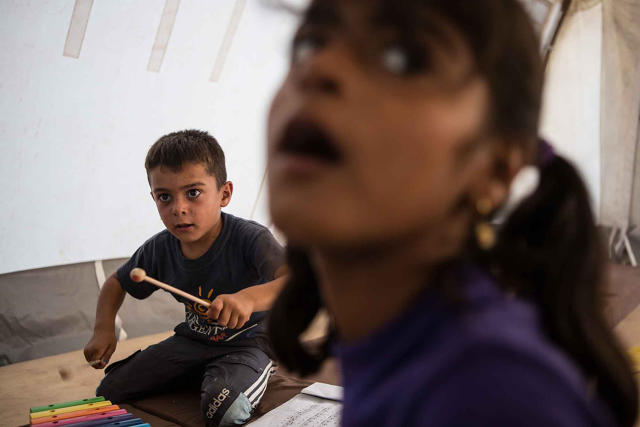
When the IRC’s board reached out to him, in 2013, Miliband saw an opportunity for mid-career reinvention. He was familiar with the IRC and admired its pedigree. And yet it was obvious to him that stasis had set in at the nonprofit. As one current IRC executive put it to me, “People felt stuck. They felt like the need was getting greater but at the same time that a lot of what we were doing wasn’t working as well as it should.”
Miliband remembers asking the members of the board, “Do you want someone to steward the organization as it is or do you want someone to take it to the next level?” Miliband was given free rein, and, fittingly, one of his first acts as CEO in October 2013 was implementing internal chat software and asking employees to tell him what was functioning well at the IRC and what wasn’t. “I wanted suggestions and criticism. I wanted people to be open with me,” Miliband says. He encouraged his staff to email him on his private account, no matter what time of day.
The feedback flowed in, prompting Miliband and his aides to devise an internal manifesto that would come to be known as IRC 2020. The plan amounts to a series of pledges to be completed within the next several years: reduce its emergency response time to 72 hours or less; increase its partnerships with other nonprofits to widen its reach; and expand both the type and amount of data-driven research it conducts and acts on. In another document, he stressed the importance of refugee empowerment to the organization’s overall resettlement and reabsorption efforts.

Miliband also green-lighted the creation of an independent research and development lab, and handed control of the unit to innovation head Ravi Gurumurthy, his former speechwriter. “From the start, David was asking, ‘How do we have the biggest impact with every dollar?’ ” Gurumurthy says. “ ‘Who are we serving? What defines success? And how are we going to differentiate ourselves from other NGOs?’ ” The R&D lab, unheard of at humanitarian aid organizations, was code-named Airbel, after a safe house maintained by resistance fighters in World War II–era France. Its 10 full-time staffers are developing technologies ranging from malnutrition-measuring devices for nurses in Africa to computer-based education software for schools in refugee camps.
The IRC has historically been funded primarily by government grants, like most humanitarian nonprofits. But because of how those dollars are often restricted, Miliband has pushed his staff to pull in more private funds. “The private money,” Miliband says, “has greater leverage. It is our venture fund.”
The IRC forged a fundraising partnership in 2015 with Whole Foods (raising $77,000 in Manhattan stores in a single day) and turned to Airbnb to get free housing for IRC staff and volunteers. Last May, it launched Mother’s Day and Father’s Day campaigns on Facebook that allowed people to choose preselected gifts ($58 for a year of school for a refugee child, for example) to donate in a family member’s name. George and Amal Clooney, Mandy Patinkin, and Rashida Jones have filmed fundraising appeals; Sir Patrick Stewart has headlined IRC events. A video of three cast members from HBO’s Game of Thrones visiting an IRC refugee camp in Greece has been viewed more than a million times.
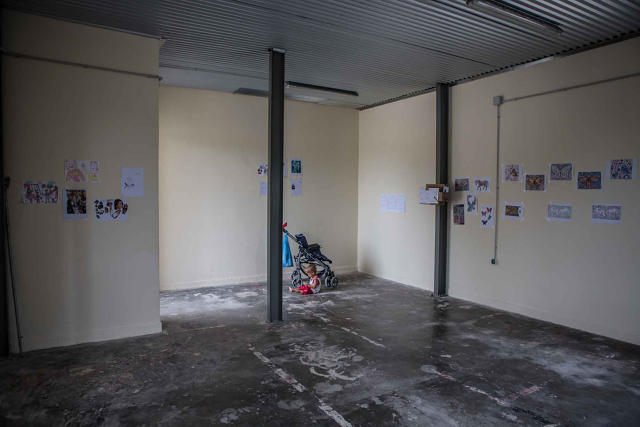
Not everyone at the IRC has embraced Miliband’s aggressive, high-profile approach, nor his emphasis on business-driven best practices (the newly installed head of procurement comes from Starbucks and the chief information officer from Johnson & Johnson). Since 2013, there have been several prominent departures. Historically, the IRC “didn’t really talk much about its work,” says one staffer, who suggested that Miliband’s focus on public outreach was perceived “to be a little déclassé.” Overall, the staffer went on, “it was a ton of change . . . for an organization that had been same-same for many years.”
Yet the impact has been clear. The IRC’s $700 million budget is 75% higher this year than when Miliband was hired, and $106 million of that has come from private sources: small-scale contributors, individual donors including Hamdi Ulukaya (the Turkish founder of yogurt giant Chobani), and corporate backers such as Citibank’s Citi Foundation. “IRC’s emphasis on evidence-based programming and scaling new breakthrough approaches through their newly launched R&D lab aligns with [our] focus on enabling organizations to think bigger and bolder about global challenges,” says Citi Foundation head Brandee McHale.
Says Amanda Seller, the IRC’s revenue chief: “You spend too much time in the sector, and you can get accustomed to the furniture, if you know what I mean. David was able to look at things objectively and ask the hard questions that needed to be asked.”

If the Miliband-era IRC has an unofficial mantra, it is “Results matter”—words I hear uttered, in various permutations, by almost every staffer I speak with. “You have to remember that this is a sector built on good intentions. We go out into the world and try to do good,” says Jeannie Annan, IRC’s director of research. “But historically, the work has been a matter of measuring output: How much food or clothing did we give out? How many people did we train on month X? Our hope now is to pivot to measuring—qualitatively and rigorously—the actual change we affect in people’s lives.”
related video: Can A Jacket That Doubles As A Tent Help Refugees?
When I sat down with Annan at her office in Manhattan, she showed me a beta of new software, currently called the Costing Tool, which is being developed by the New York tech firm Tigerspike for use by IRC project managers. The interface resembles Turbo Tax: Users answer simple questions about costs and expenditures; the program runs the figures through an algorithmic engine and spits out suggestions on how to better allocate resources or cut down on inefficiencies.
The Costing Tool has been tested so far by IRC project managers in Pakistan and Liberia, and an organization-wide rollout will begin in 2017. (Eventually, Annan says, the IRC will share the software with other nonprofits and aid groups.) “What we want is for people to be able to look at a given project and quickly figure out what’s helping, and what’s not, without having to consult an economist,” Annan says. “It’s an evidence-based approach, and you see something similar across IRC, from the amount of data we’re collecting down to the number of academic partnerships we’re doing. It’s now at the center of our strategy.”
Annan, who has a doctorate in counseling psychology from Indiana University Bloomington, mentioned a recent study her 27-person team had conducted in conjunction with academics at Yale and the University of Brasilia. The subject was emergency cash distribution—a relatively new practice, based on the theory that while food and water are important in the immediate aftermath of a disaster, survivors themselves will always be best positioned to know what their families need in the long term. In most of these cash-distribution programs, recipients access the funds through preloaded swipe cards—similar to the Electronic Benefit Transfer cards that the U.S. government uses to distribute welfare benefits. In this case, the money arrives monthly, in amounts tailored to the size of the family.

Critics of cash distribution have worried that recipients could be targeted by thieves, or that funds could find their way into the hands of terrorist groups. But this new study, which focused on a group of Syrian refugees in Lebanon, found little support for those concerns. Moreover, families that received cash assistance (and thus a measure of monetary freedom) tended to be significantly happier than the families that were given predetermined quantities of food and supplies. Tension in the household was reduced. And the program boosted the local economy: Most of the money was spent at Lebanese stores.
Encouraged, the IRC has expanded its cash-distribution program to refugees across the region, and late last year, opened one of the first of its kind in Europe, at the Eleonas refugee camp in Athens. In June, I traveled to the camp to attend an informational session for about 45 recipients, who sat quietly sweating in an airless white tent as a tinny recording of a muezzin calling the faithful to prayer filtered in from an adjacent shelter.
Danny Dibb, a Lebanon-based IRC staffer helping to manage the cash program in Eleonas, had brought along some early statistics on card use, and he opened the meeting by reading them aloud, in Arabic. (Keeping residents involved keeps them invested, he tells me later.) So far, each of the roughly 300 families living at Eleonas had been issued a card in the amount of 290 euros, which would be replenished on a monthly basis. Statements indicated that the bulk of spending was done at Athens supermarkets, although a number of families had invested at least part of the funds to re-up the talk and data minutes on their smartphones. The presentation lasted a quarter of an hour.
“Questions?” Dibb asked when it was finished.

Someone asked if families could get money sooner if they needed it. (They could not.) Was there any chance they might receive actual cash, as opposed to a swipe card? (Not for the time being.)
A stoop-shouldered man in a purple shirt raised his hand. “I’d like to be able to use my card on the Metro,” he said. Other participants nodded vigorously.
Dibb promised to look into it.
That same day, I followed an Eleonas resident named Malak Mohammed Jito on her weekly grocery run. Jito, who is Kurdish, had fled Syria with her husband eight months earlier in the hopes of joining their three sons in Germany. Upon arriving in Greece, she’d been informed that Germany wasn’t letting in more Syrians.
Now penniless—her house had been destroyed by a bomb, and all the family’s money had gone to smugglers who got her out of Syria—she hoped to get to France or England, within visiting distance of her grandkids. But in the meantime, she was determined to make a home for herself and her husband wherever she was. Slight and elegant, clad in a brightly patterned shirt and navy head scarf, Jito wove up and down the aisles of the nearby grocery store, picking up a bag of oranges and yogurt that she would eat that afternoon—her temporary housing was not equipped with a refrigerator. She used her card to pay for the items.
“Our lives here, there isn’t a lot of choice,” she said through a translator on the way back to the camp. “Where we live, what our days are like. You can’t work. But being able to do the little things, to choose ingredients and prepare your own meal, there’s a dignity in that.”
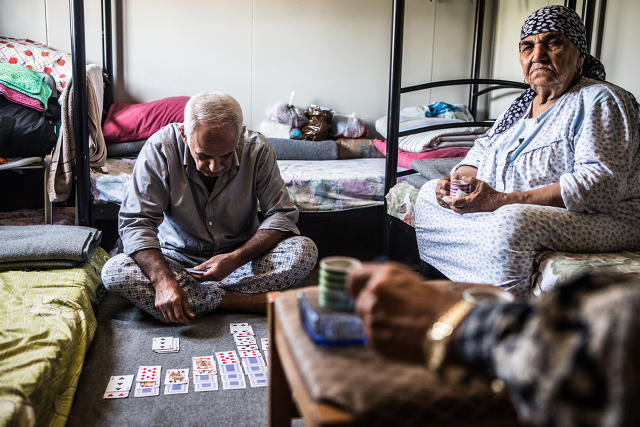
In recession-rattled Greece, which has sheltered more Middle Eastern refugees than any other country in the European Union—some 1 million registered since 2014—the IRC’s primary role has been to provide the types of services the government regularly can’t, from education to counseling to food distribution. “The pressure is incredible,” says Ioannis Keramidakis, a senior IRC engineer, while giving me a tour of the Diavata camp, near the northern Greek city of Thessaloniki.
Diavata is the newest of 23 government-run camps in the country. The IRC and several other major nonprofits had been invited in February to assess the area, then an abandoned military barracks owned by the Greek army. A so-called cluster meeting was convened, with officials from various nonprofits—including Save the Children and Doctors Without Borders—divvying up the portfolio of pressing needs. (General camp administration and security falls to the Greek state and police forces.) The IRC volunteered to handle what is known, in nonprofit shorthand, as WASH duties—water, sanitation, and hygiene.
The task, Keramidakis says, was daunting. A single pipe led into the camp, and for nearly 3,000 refugees, there was only one line of chemical toilets and three showers. Residents had nowhere to dispose of trash. On a budget of roughly $300,000 from European Union humanitarian grants, Keramidakis and his team set to work extending the water pipeline and erecting 100 squat toilets, along with three shower facilities that would be powered by diesel engines. They erected a kiosk for soap and shampoo distribution and put a call out for bids from local sanitation contractors.
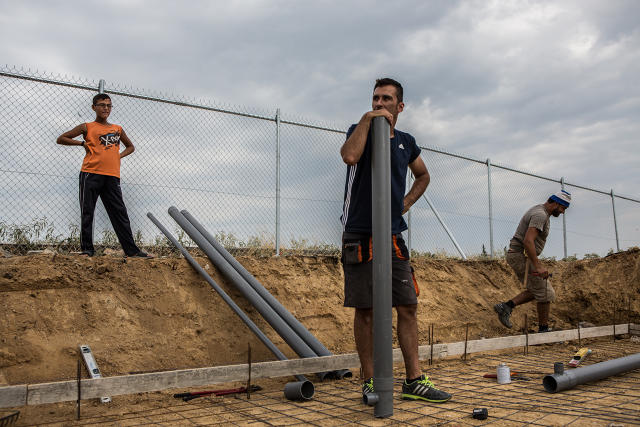
“We’re working on adding some more washing units and more taps, so that people can launder their clothes,” says the lean and gray-haired Keramidakis, as I follow him up the dirt road that bisects the camp. The day is overcast but still broiling, and soon Keramidakis’s high forehead is covered by a sheen of sweat and dust. We watch a garbage truck roll up, and contractors in IRC bibs begin filling it with trash.
A few yards away, a handful of shirtless boys play soccer on a dirt patch that once served as the barracks’ rifle range. Behind them, an IRC construction team nails together the frame of a two-room building that will house a counseling and activity center for young male refugees. I MISS YOU, SYRIA, someone has written with neon blue spray paint on one of the boards.
“So you can see, we’re getting there,” Keramidakis says.
As the crisis has evolved, so too has the type of relief the IRC offers to refugees, most of whom have few options for onward travel. A closure at the Macedonian border has effectively strangled the main overland route into Northern Europe. Meanwhile, the EU has been overwhelmed with asylum requests. It is not unusual for refugees to wait more than a year while their statuses are sorted out. During that time, they cannot work. Their days are idle, often spent smoking cigarettes or playing on their phones. Hopelessness frequently sets in.
Mohamed Alheady, an Iraqi living with his wife in the Diavata camp, tells me that at home, he’d had lofty aspirations: “A big job, a big future. Now, in the camp, I dream only of cold water.” Was it possible he regretted leaving Iraq? To my surprise, he nodded. “At least there, ISIS would kill us quickly,” he said, and mimed decapitation.
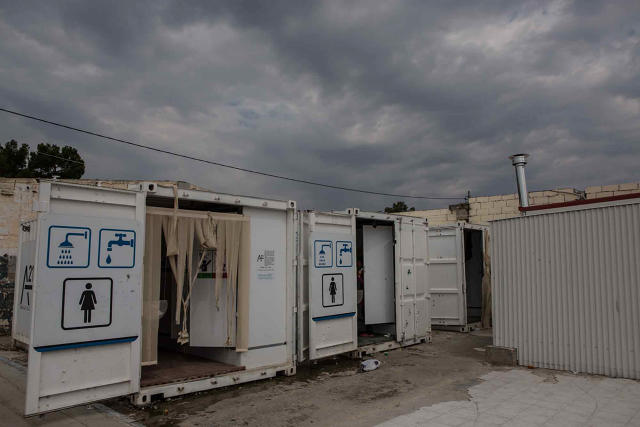
A day later, I meet a young couple, Samir and her husband, Mukhtar, who have come to Greece from a rural area north of Algiers. (Fearful for the safety of their family, they requested that I use only their first names.) They are both tall and attractive, Samir’s lips painted an optimistic shade of pink. But they wear the unmistakable glaze of trauma, equal parts fatigue and resignation. Days earlier, they explain, they had attempted to cross the Aegean from Turkey with 11 other refugees, including three Syrian children. Halfway into their journey, at around two in the morning, the boat capsized, spilling the passengers into the water. People began screaming. The three Syrian children were floating ominously on their bellies. “The littlest boy, you could see he was gone,” Mukhtar recalled. “I tried to tell the mother to leave him, but she just held on tighter.”
In all, Mukhtar and Samir spent eight hours in the water. At 10 a.m., they were spotted by a merchant vessel, transferred to a Greek police ship, and carried to the camp. A young volunteer there delivered the bad news: Of the 13 people onboard the dinghy, seven had drowned.
Samir peels down the front of her shirt to show me the jellyfish stings that tattoo her chest. The scars will likely never fully fade. But she could cope with scars, she said. The nightmares were another matter. “I will never forget what she said,” Samir says of the grieving mother, her eyes bright with tears. “She said, ‘Please, God, forgive me. Forgive me: For Europe, I killed my children.’ ”
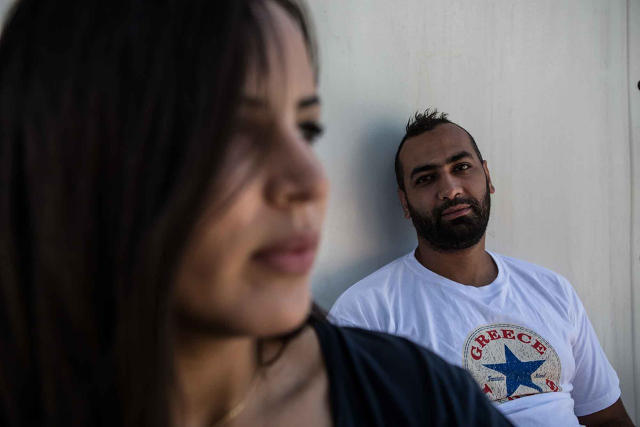
Like many refugees, Samir and Mukhtar are receiving counseling from psychologists employed by IRC, which has stepped up its funding for psychiatric aid to those in the camps. The organization has built and staffed so-called safe spaces where refugees can find release from the pressures of camp life; employees are working on software that would allow psychologists to track patients across borders, preventing at-risk refugees from dropping off the radar entirely.
An IRC psychologist named Kiki Michailidou says she attends regularly to patients who show signs of severe post-traumatic stress disorder. Suicide attempts are not uncommon. Michailidou distributes medicine when possible; she can also recommend hospitalization. “I do feel as if we can provide people a lifeline, and support, even if it’s temporary,” she says.
“You have to say to people, ‘Look, it’s insanely bad. I know it’s insanely bad,’ ” says another IRC psychologist, Roose Bollen. “ ‘But it won’t be like this forever.’ And then you have to look them in the eye and get them to believe you.”

Since 1994, the International Rescue Committee has been headquartered in the Chanin Building, an art deco tower in midtown Manhattan, across the street from Grand Central Station. Traditionally, the chief executive has worked out of a 14th-floor aerie, but when Miliband came aboard, he moved himself to a glass-walled cube on the 11th floor, closer to the rest of his staff. “I felt too removed up there,” he explains when I meet him at his office last spring.
At 51, Miliband still has the body mass of an unfolded paper clip—he does not so much sit in a chair as extend off it. He rubs his eyes tiredly. The previous night, he’d appeared with former U.S. Secretary of State Madeleine Albright, a friend and mentor, at the 92nd Street Y, for a conversation billed as “A Decade of Disorder.” Toward the end of the event, Miliband had mused aloud about the “chasm,” as he put it, between the need of refugees and displaced people and the ability of the international community to provide it. One could assume that the issue was apathy, he’d told the audience. But in his opinion, the likelier explanation was another kind of disconnect: “People don’t know how to help, and they worry that their help won’t make a difference.”
Now, in his office, he picked up where he’d left off. “We’re in a growth industry, for all the wrong reasons,” he says. “But you can’t let people give in to compassion fatigue. You have to say, ‘No, listen, I promise, you can make a difference.’ You have to represent hope. And then you have to put aside the temporary, easy solutions, and go after lasting, sustainable, impactful change.”
In the current political climate it hasn’t always been easy for him to maintain his enthusiasm. Naked anti-refugee and immigrant furor has been stoked by politicians in Europe. In the U.S., Donald Trump, who campaigned on vows to bar all Muslims from entering the country, has won the presidency. Already, there are fears that public funding for refugee-related programs could dry up under the new administration.
I ask Miliband if he ever feels daunted by the task his organization faces. “If you only look at the statistics, yes, it’s depressing,” he says. “But then you talk to the people, and you remember why you’re doing what you do.”
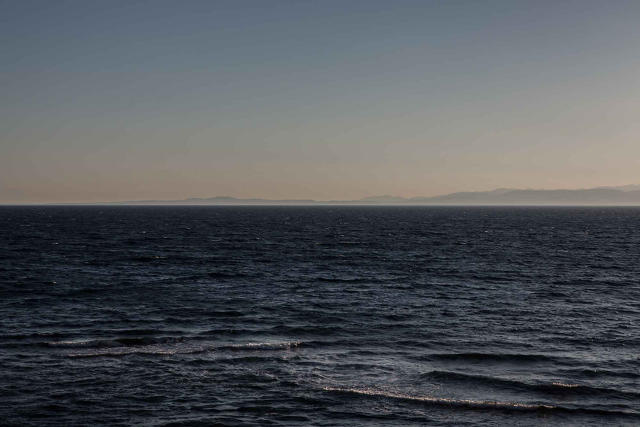
A few weeks ago, he visited an IRC-funded farm in the Bronx, where resettled refugees teach agricultural classes to elementary school students and grow produce to sell to local restaurants. Among the people he met was a young woman named Rose, who had fled war in the Central African Republic. Now she was planning to start her own line of artisanal honey. “She’d been through hell,” Miliband recalls, but she was determined to move on. He finds himself profoundly moved by her resilience, along with that of the thousands of other refugees the IRC resettles in the United States each year.
In September, Miliband attended the United Nations’ annual summit on refugees. He listened as Secretary General Ban-Ki-Moon outlined the expanding dimensions of the crisis, and as President Obama pledged that the United States would take in 110,000 refugees from around the world in 2017, up significantly from 2016. That same week, Miliband published a long article in the New York Review of Books, in which he remembered a conversation he’d once had with his friend, the late author Elie Wiesel. “The word refugee is not popular,” Wiesel, a former refugee himself, had told him. “But everyone likes the idea of refuge. Fight for refuge. We all need refuge.”
A version of this article appeared in the December 2016/January 2017 issue of Fast Company magazine.
Fast Company , Read Full Story
(53)

